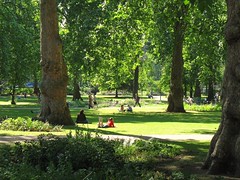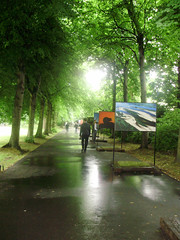density + parks = smart

Posted November 15, 2007 at 9:33PM
This post is going to be about city and neighborhood parks, but first I need to set the context:
Fortunately for the planet, a lot of people in the world of planning, transportation and development have figured out that we can’t keep building all over the place, and that the antidote to sprawl is to take advantage of infill and redevelopment opportunities, build around public transit, and build suburbs that don’t leapfrog across the countryside but do make more efficient use of land. This is pretty much the capsule definition of smart growth, and it works, by reducing per capita traffic, global warming emissions, polluted runoff, land consumption and a whole lot more. I like to think of it as “density done right.”
 Although the “D” word scares the hell out of some people, it needn’t. This isn’t about forcing everyone into high-rises but simply offering a range of housing choices near jobs and amenities, so that the average density of a community goes up incrementally. Some of our country’s most beloved communities, such as Old Town Alexandria in Virginia, Cleveland Park in Washington, DC, Oak Park near Chicago, and even Pasadena in California were built just this way. These places command high prices today in part because the type of community they represent has become scarce in today’s housing market.
Although the “D” word scares the hell out of some people, it needn’t. This isn’t about forcing everyone into high-rises but simply offering a range of housing choices near jobs and amenities, so that the average density of a community goes up incrementally. Some of our country’s most beloved communities, such as Old Town Alexandria in Virginia, Cleveland Park in Washington, DC, Oak Park near Chicago, and even Pasadena in California were built just this way. These places command high prices today in part because the type of community they represent has become scarce in today’s housing market.
So there is no question that we have figured out how to sell this vision to potential residents. What we haven’t done very well is sell it to neighbors, who typically feel threatened by the prospect of more buildings and people where they live. Although it annoys me when they try to use environmental arguments to oppose something that is good for the environment, their concern is understandable given most of what they have seen in development over the past half-century.
 I think we smart growth advocates could serve ourselves well by spending more of our energy on what the kind of development we know we need – smarter, denser neighborhoods – can bring to the neighbors along with the buildings and people, and I propose we start with parks.
I think we smart growth advocates could serve ourselves well by spending more of our energy on what the kind of development we know we need – smarter, denser neighborhoods – can bring to the neighbors along with the buildings and people, and I propose we start with parks.
City and neighborhood parks are wonderful places, where my dad taught me to fly a kite, where I honed my guitar chops as a law student, where I eat lunch sometimes as a grownup, and where my wife and I take our walks, whether we are in town or traveling.
But my sense is that we are not getting enough of them with our new development, even with our smarter development, and maybe even especially with our smarter, denser development. Here in the DC area, I see lots of good, transit-oriented and other smart growth development in places like Bethesda, Silver Spring and Arlington, but I seldom see any new public green space to accompany it. Why?
 I have a theory about this: the great city and neighborhood parks in this country were mostly built in the 1800s and the first half of the 1900s, when they were a source of civic pride. Other great institutions were built then, too, such as grand libraries and stately schools. But, since then, the financing seems to have changed. The public sector can no longer afford to build places this nice.
I have a theory about this: the great city and neighborhood parks in this country were mostly built in the 1800s and the first half of the 1900s, when they were a source of civic pride. Other great institutions were built then, too, such as grand libraries and stately schools. But, since then, the financing seems to have changed. The public sector can no longer afford to build places this nice.
That leaves it to the private sector, but because in most cases the private sector builds incrementally, small parcel by small parcel, they have neither the space nor the motivation to provide them, especially when building infill projects. In addition, because people seldom work, shop and sleep in the same community anymore, there isn’t the same sense of civic ownership of a place anymore to create a feeling of community responsibility.
So I say let’s turn this around and start finding ways to pool development money into new parks that come with the increased density. And that’s important – we can’t make the mistake of advocating parks instead of infill and more compact development, or else we will just be creating incentives for sprawl. But neither should we advocate density without parks. My friend Peter Harnik at the Trust for Public Land has figured this out, and recently hosted a colloquium on how we can better combine density, parks, and affordable housing. That is exactly the right way to think about these issues in the 21st century. At NRDC, we’re going to help with that as much as we can.
 My developer friend Jonathan Rose, who works with both TPL and NRDC, has built a great model of integrating these key components of community at one of his best developments, the aptly named Highlands’ Garden Village in Denver. It’s a wonderful project in a lot of ways, and I may write about it at length at some point. But he has sprinkled it with community gardens and parks throughout, and still has great residential density at about 15 homes per acre, and additional commercial space as well.
My developer friend Jonathan Rose, who works with both TPL and NRDC, has built a great model of integrating these key components of community at one of his best developments, the aptly named Highlands’ Garden Village in Denver. It’s a wonderful project in a lot of ways, and I may write about it at length at some point. But he has sprinkled it with community gardens and parks throughout, and still has great residential density at about 15 homes per acre, and additional commercial space as well.
So let’s don’t forget the great examples of what we can do, like my all-time favorite, Russell Square in London. Now there’s a city that knows how to do parks, by the way. Or Jonathan’s pocket parks and greens in Highlands’ Garden Village. Or, for that matter, St. Stephen’s Green in downtown Dublin. One fall day Paddy Moloney of the great musical group the Chieftains and Van Morrsion took a stroll there; by the time they emerged they had cooked up their classic and highly recommended collaboration, Irish Heartbeat. I rest my case.